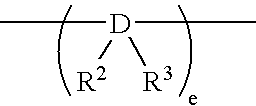Higher alpha-olefin copolymers and process for preparation thereof
- Summary
- Abstract
- Description
- Claims
- Application Information
AI Technical Summary
Benefits of technology
Problems solved by technology
Method used
Image
Examples
example 1
In a 10-liter autoclave which was dried by heating, 2.8 kg of “Linearen 2024” (a mixture of predominantly a-olefins having 20, 22 and 24 carbon atoms), a product of Idemitsu Petrochemical Co., Ltd., and 4 liters of heptane were charged, the mixture was heated to the copolymerization temperature 60° C., subsequently 5 mmol of triisobutylaluminum, 20 μmol of (1,2′-dimethylsilylene)(2,1′-dimethylsilylene)-bis(3-trimethylsilylmethylindenyl)zirconium chloride and 40 μmol of dimethylanilinium tetrakis(pentafluorophenyl)borate were added, and copolymerization was carried out for 8 hours, with introducing 0.1 MPa of hydrogen.
After the completion of copolymerization reaction, the reaction product was precipitated in acetone, heated and dried under reduced pressure to yield 1.5 kg of a higher α-olefin copolymer.
The results of measured physical properties of the copolymer thus obtained are shown in Table 1.
example 2
Into a 1-liter autoclave which was dried by heating, 200 ml of 1-octadecene (C18) and 200 ml of heptane were added, the mixture was heated to the copolymerization temperature of 60° C., subsequently 0.5 mmol of triisobutylaluminum, 2 μmol of (1,2′-dimethylsilylene)(2,1′-dimethylsilylene)-bis(3-trimethylsilylmethylindenyl)zirconium dichloride and 10 μmol of dimethylanilinium tetrakis(pentafluorophenyl)borate were added, and copolymerization was carried out for 8 hours, by further introducing 0.1 MPa of hydrogen and 0.03 MPa of ethylene.
After the completion of copolymerization reaction, the reaction product was precipitated in acetone, heated and dried under reduced pressure to yield 32 g of a higher α-olefin copolymer.
The results of measured physical properties of the copolymer thus obtained are shown in Table 1.
example 3
In a 1-liter autoclave which was dried by heating, 400 ml of a heptane solution containing 140 g of “Linearen 2024” (a mixture of predominantly α-olefins having 20, 22 and 24 carbon atoms), a product of Idemitsu Petrochemical Co., Ltd., 40 ml of 1-butene were charged, 0.1 MPa of hydrogen was introduced, and the mixture was heated under pressure at the copolymerization temperature of 60° C.
Then, 5 mmol of triisobutylaluminum, 5 mol of (1,2′-dimethylsilylene) (2,1′-dimethylsilylene)-bis(3-trimethylsilylmethylindenyl)zirconium dichloride and 25 μmol of dimethylanilinium tetrakis(pentafluorophenyl)borate were added, and copolymerization was carried out for 120 minutes.
After the completion of copolymerization reaction, the reaction product was precipitated in acetone, heated and dried under reduced pressure to yield 17.6 g of a higher α-olefin copolymer.
The results of measured physical properties of the copolymer thus obtained are shown in Table 1.
PUM
| Property | Measurement | Unit |
|---|---|---|
| Temperature | aaaaa | aaaaa |
| Temperature | aaaaa | aaaaa |
| Temperature | aaaaa | aaaaa |
Abstract
Description
Claims
Application Information
 Login to View More
Login to View More - Generate Ideas
- Intellectual Property
- Life Sciences
- Materials
- Tech Scout
- Unparalleled Data Quality
- Higher Quality Content
- 60% Fewer Hallucinations
Browse by: Latest US Patents, China's latest patents, Technical Efficacy Thesaurus, Application Domain, Technology Topic, Popular Technical Reports.
© 2025 PatSnap. All rights reserved.Legal|Privacy policy|Modern Slavery Act Transparency Statement|Sitemap|About US| Contact US: help@patsnap.com



